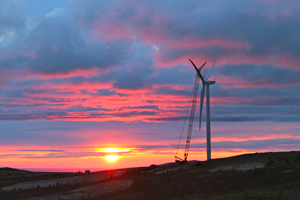An Alaskan Adventure: The logistics of Eva Creek
 Whether it’s five miles of underground collection systems, six inches of clearance on an essential railroad bridge, or 24 hours of light each day, numbers often tell the story when it comes to a wind farm. This is especially true of the construction of Eva Creek Wind Farm—the largest wind project in Alaska.
Whether it’s five miles of underground collection systems, six inches of clearance on an essential railroad bridge, or 24 hours of light each day, numbers often tell the story when it comes to a wind farm. This is especially true of the construction of Eva Creek Wind Farm—the largest wind project in Alaska.
The 24.6-megawatt (MW), 12-turbine wind farm was constructed in Ferry, Alaska between April and October of 2012, but it took months of additional planning, particularly in relation to the complex logistical issues of this project.
To save you from pulling out a map, Ferry, Alaska is a remote city. Located 100 miles south of Fairbanks, and 250 miles north of Anchorage, Ferry is found just outside Denali National Park. It’s close to Mount McKinley, the tallest peak in North America, which is in clear sight of the turbines on a clear day. A prime location for a wind farm, perhaps, until the issue of getting there is taken into account.
The road less taken
Because of how remote Alaska’s interior is, transportation was the primary challenge during the construction of Eva Creek. Every component of the wind turbines—from generators to blades—along with all of the vehicles and crew members needed to cross an existing railroad bridge, over the Nenana River, to access the construction site. This bridge barely afforded six inches of clearance between the equipment and the trusses. Gravel and sand for road improvements and concrete projects were the only components to be sparred passage over the bridge during this time.
Project site clearing and grubbing was done in preparation from August to November 2011, before the project shut down for winter. In 2012, the six months between April and October provided just enough of a weather window for construction to get completed. During that time, tiny Ferry, Alaska (which has an average population of 30) bustled with activity, as more than 100 project team members and a man-camp descended on the area.
In total, the project included:
• 13 miles of upgraded or new access roads;
• 12 turbines on 80-meter towers;
• 12 concrete spread foundations;
• Five miles of an underground collection system—installed in permafrost, rock, and arctic conditions;
• A 230-kilovolt (kV) substation; plus
• Two operations buildings, two communications towers, and one meteorological tower (another two meteorological towers were also relocated).
Most of the materials, and all of the vehicles and turbine equipment, were transported by truck from either Fairbanks or Anchorage to Healy, which is 14 miles southeast of Ferry. A mammoth crane was the largest piece of equipment moved to the site. It was broken down into 42 component pieces, shipped by barge and rail to Healy, from its last project in California. Other equipment included everything from lattice boom and hydro-boom cranes to haul trucks, excavators, loaders, graders, rollers, and dozers. There were even tractors with specially designed trailers, portable batch plant, rock crushers, drill rigs, and ready-mix concrete trucks.
Once the equipment and all of the materials crossed the bridge, it was off-loaded at a rail siding before being transported 10 miles up a mountain road. This was managed at grades as steep as 10%, so as to ensure the two strings of turbines made it to the top. The road was built specifically for the project, and remains in use today, providing access to the turbines for maintenance.
A high-wind venture
.jpg) Planning and preparation were critical to the success of Eva Creek. Not only was the project done on a tight schedule, but the only option for any must-have, on-the-fly materials was an auto parts store about 15 miles away. Otherwise, additional supplies had to get driven in from about 100 miles away.
Planning and preparation were critical to the success of Eva Creek. Not only was the project done on a tight schedule, but the only option for any must-have, on-the-fly materials was an auto parts store about 15 miles away. Otherwise, additional supplies had to get driven in from about 100 miles away.
Transportation was, of course, only part of the challenge in building this wind farm. It wouldn’t be a project worth mentioning in the 49th state without some words on the weather. During the seven-month work span, temperatures ranged from as high as 72° F to in the lows of -20° F. Winds often exceeded 70 miles-per-hour (mph), topping out at 84 mph. Record amounts of rain in June damaged one of the access roads, which was rebuilt with more aggressive erosion-control measures.
However, the land of the midnight sun did provide some extra working hours, with nearly 24 hours of straight daylight for part of the construction season. Although the spring and fall only allowed for about seven hours of light conditions, the long days in-between meant longer working hours for many. During the longest days, some sub-contractors opted to run two shifts per day.
The Eva Creek Wind project received $13.4 million in state grants, and will meet owner Golden Valley Electric Association’s goal of having 20% of the system’s peak load generated by renewable resources in 2014.
The towers have been commissioned and are successfully generating electricity, showing anything is possible with determination and the right plan in place.
Jill Badzinski is corporate writer at Michels Corporation. Michels Wind Energy, a division of Michels, was the EPC contractor on the Eva Creek Wind Farm.
Michels Wind Energy
www.michels.com
Author: Jill Badzinski
Volume: March/April 2013








